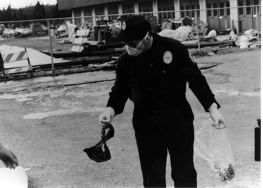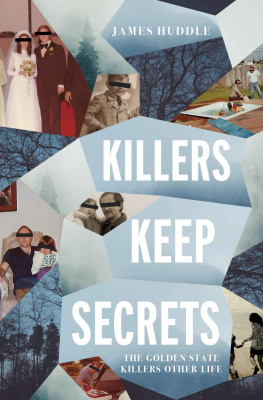
IN MEMORY OF
Robert and Beth Hale
Major Walter J. Gilmour, AST, Retired
L.E.H.
TO
Major Mike Korhornen
and all the civilian personnel without whom
there wouldnt have been a case.
W.G.
Acknowledgments
The authors would like to thank the following people for their support and assistance during the sometimes trying journey Butcher, Baker took from first draft to final publication: Marie Chevrier; Robert Lescher, our agent, and Mickey Choate, his assistant; Michaela Hamilton, our editor, and everyone at NAL/Dutton; Virginia Gilmour; Mark and Frances Hale; Martha Hale; Maxine Farrell; Glenn Flothe,. Rollie Port, and everyone at the Alaska State Troopers; the Alaska Department of Public Safety; the Anchorage Public Library; the Chevrier sisters, Gail and Darlene; Marvin Wiseman; Ralph Hudek; Mr. and Mrs. Ken Richardson; Mrs. Myrtle Merryman; Kerry Conrad and the Anchorage Times ; Nick Lamberto of the Des Moines Register ; Joann Henning and her son, Darin Galle; and Ann Rule.
Authors Note
This is a work of nonfiction. While much of the dialogue in it is taken directly from court and police transcripts, there are numerous instances in which it has been reconstructed on the basis of the authors interviews with relevant individuals. In addition, certain scenes have been dramatically recreated in order to portray more effectively the personalities involved in this story and the atmosphere surrounding the events upon which this book is based.
It should be emphasized that a police investigation produces conflicting versions of events. Where such conflict exists, the authors have sought to provide the version which in their opinion is the most credible.
The real names of the people involved in this story have been used, except for Kitty Larson, Robyn Patterson, and Melanie Michaels. The authors have chosen to disguise the identities of these people to preserve their privacy. Any similarity between the fictitious names used and those of living persons is, of course, entirely coincidental.
Introduction
Forty-six years ago, Robert Hansen came to Alaska on an odyssey that culminated in violent attacks on women. By the time of his arrest and conviction, there were between fourteen and 27 suspected killings. Eyewitness accounts indicated a cruel mind who planned a humiliating and deadly experience for his victims. His care in planning and use of Alaskan wilds as a graveyard allowed him to continue to prey on women almost with impunity. Interestingly enough, he was identified with an emerging M.O. as early as 1972. At his sentencing, Judge Moody noted that we are told of cases falling through the cracks in the criminal justice system. This case was pushed through a hole.
Even as the Hansen case was unfolding, the Alaska State Troopers developed protocols for sexual assault and reached out to Seattle Rape Relief for assistance in building and supporting advocate safe houses in Alaska. Today, most cities in Alaska have an advocate system involved with rape investigations. Additionally, the Department of Public Safety in Alaska has built a $56 million crime lab to speed evidence processing. More is needed. We know that assaults of all types provide a breeding ground for murder.
In 2013, the University of Alaska Justice Center released data which reflects the percentage of Alaska women being assaulted. The data indicates that Alaska is number one in the U.S. for sexual assaults. Clearly the environment from 1972 to the present does not indicate a vast improvement in outcomes.
The behavioral profile of present day serial killers and mass murderers too often matches that of Robert Hansen. We need to identify those behaviors early on and take steps to ameliorate them. As a first step, the authors urge: See something, say something.
If there is any good news here, Robert Hansen remained in prison throughout his 461 year plus life sentence, spending many of them as the jailhouse barber. Hansen died of natural causes on August 21, 2014, at the Anchorage Regional Hospital. He was 75 years old.
Of Robert Hansens death, Glenn Flothe, the retired Alaska state trooper who was instrumental in Hansens 1984 capture, said: On this day we should only remember his many victims and all of their families, and my heart goes out to all of them. As far as Hansen is concerned, this world is better without him.
Walter Gilmour and Leland E. Hale, authors
June 2016
Part One
Anchorage, Alaska
Sunday, June 13, 1983
The baker snatched her off the street at Fifth and Denali. Right in the heart of town, where all the hookers hang out. He couldnt stop himself. Never can. When he wants something, he takes it.
This ones name was Kitty Larson. Known to her parents as Victoria Matthew. Like so many others, she was pretty and seventeen.
By the time she got to his house, he had slapped handcuffs on her. Then he dragged her to his basement and raped her. Shed had strange sex before, but nothing like this. Tell me you want it, he demanded. She started to cry, wishing shed never gotten in this mans car. She should have known the two hundred bucks hed offered was way too much for a lousy blowjob.
Tell me you want it, baby, he repeated.
She didnt say anything. It didnt matter. He came quickly. But Kitty had other things to worry about, like how to escape.
Maybe if I go to the bathroom, she thought, I can crawl through a window. She told him, I have to go real bad. It hurts, I gotta go so bad. He nodded in agreement, but only after putting a thick nylon rope around her neck. He held it taut like a leash until she started to pee. When the rope suddenly went slack Kitty dashed to the bathroom window. It was nailed shut. Shit.
The sound of heavy chains rattling in the den brought her back to the bathroom door. They made a sharp, ringing sound as they dragged across the floor. She stood with her toes to the doorsill, silent as a church mouse. She was so paralyzed she was almost afraid to breathe. Hes gonna kill me, she thought. After what he did, he has to kill me.
Kitty didnt wait to find out what he had planned next. No way was he going to trap her in the bathroom. The door nearly came off the hinges as she hurled it open. She stood before him stark naked. He looked her over with tight, beady eyes. Go back in, he said, his voice flat and demanding.
Kitty had always been a rebel, the girl in the principals office. Now she was the prisoner confronting her captor. No, she said. No.
I said go back in, he repeated, his voice now edgy and mean. She stood her ground. Before she could move, however, she found herself grabbed and chained to a sturdy wooden post in the middle of the den. The baker fondled the shiny silver tow chain before winding it around her neck four times. It was an unsettling ritual, because he clearly enjoyed it.
If you cooperate, I wont hurt you, he said, tightening the chain around her neck. And then he was standing nose to nose with her, stealing her breath, violating her sight. His face was a lunar landscape of acne scars and what looked to her like facial warts. He was ugly, she decided, with horn-rimmed glasses and slick hair that gave him the look of a gawky adolescent whod grown old but not up.
Almost as quickly she saw a gentler side of him. From somewhere he grabbed a brown, yellow and orange afghan. He looked almost kind as he wrapped her in its comforting folds. Im tired, he told her. I havent slept in a long time. Im gonna go to sleep on the couch. And d-d-d-dont wake me up, he stuttered, or youll m-make me mad. And you d-dont want to see me mad.
His face had regained its hardness and his eyes were flinty and faraway. Most important, a gun was in his hand. Kitty tried to look compliant. He reacted by walking away without even changing his expression. Then he turned on the television. Here, he said, trying to put her at ease again, you can watch TV while I sleep.
Next page











